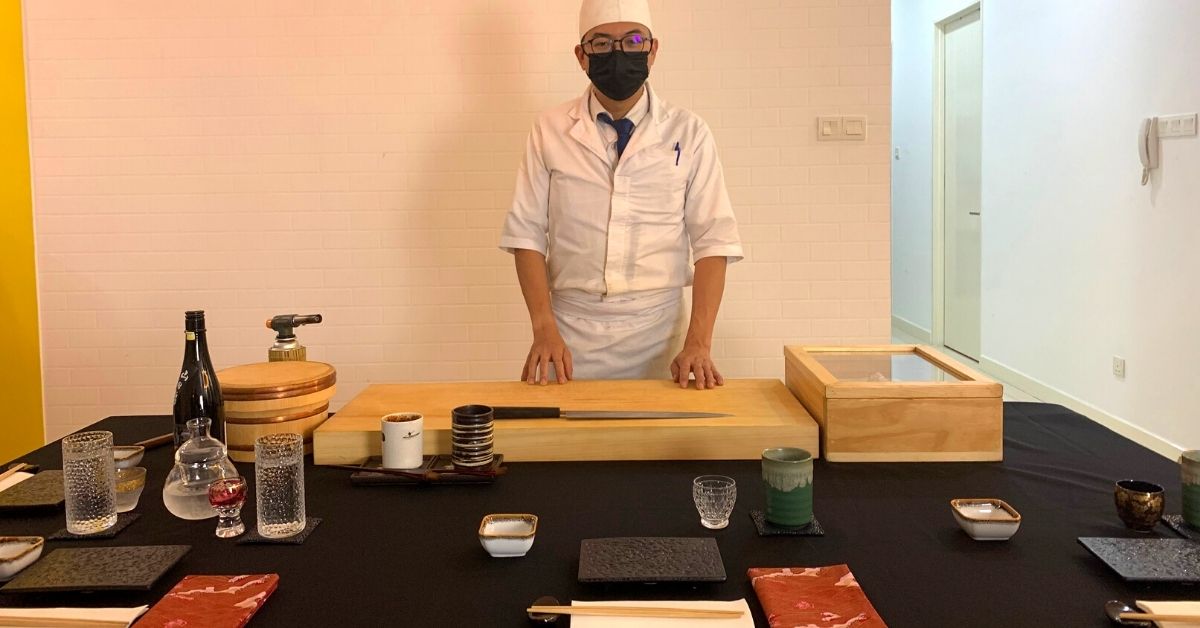Author’s Blurb: As someone who enjoys the occasional conveyor belt sushi, I’m not exactly willing to fork out money for premium sushi from Japanese fine dining spots. Over the lockdowns, I actually haven’t eaten sushi as it’s always felt like an experience that’s more worth it for dine-ins.
After launching on March 31, 2021, premium Japanese restaurant Umi Omakase decided a month in to bring its sushi to customers. Not just through takeaways and deliveries, but by actually getting its sushi chefs to visit customers’ homes for a unique omakase experience, making the dishes fresh in front of them.
Omakase is a phrase that literally translates into “I’ll leave it up to you”. It’s most commonly used when dining at Japanese restaurants where the customer leaves it up to the chef to select and serve their current seasonal specialities.
Making themselves at home

The restaurant calls their private dining experience Homakase, a portmanteau of the words home and omakase. Mr. Liow, the restaurant’s director, told Vulcan Post that the idea to launch Homakase stemmed from the discomfort some Malaysians felt while dining out during the CMCO earlier this year.
“This is another way for people to have a chance to experience omakase at home,” he shared.
Bookings must be made 3 days in advance so the restaurant can determine how to split its kitchen team and prep the needed equipment. The team will also ask customers about their dietary preferences and allergens to avoid, such as specific seafood or shellfish.
Chefs will then begin packing up their ingredients into an ice box which include whole fishes, cooked sushi rice, seaweed, and other kinds of seafood like uni (sea urchin).
On the predetermined date, the chef will arrive at a customer’s home an hour earlier from the arranged time. They’ll then begin setting up their station, using all the materials packed up from the restaurant.

“We will do everything in front of customers like cutting fish, shaping rice, wrapping seaweed, etc. just like how they get to experience at our restaurant,” explained Mr. Liow.
Even the plates and cutlery are prepared by the chefs, using tableware from Umi Omakase’s restaurant. The whole Homakase experience lasts for 3 hours, after which the chefs will pack up any leftover fish, dishes, and equipment before departing, leaving their customers’ homes spotless.
Fresh from the ocean

Umi Omakase claims to source its seasonal seafood fresh from the oceans of Japan. Meanwhile, its restaurant’s design is described to carry the Zen philosophy in mind. Simply looking at pictures of the restaurant, it’s clear a lot of thought and care went into it; one can only imagine being there in person.
From their menu, omakase is served as lunch and dinner packages at the restaurant, which can cost between RM150-RM480 and RM450-RM1,180 respectively, depending on the ingredients used.
The restaurant’s chefs are headed by Chef Shiga who has established himself as a well-known omakase chef in Japan. He’s regularly invited overseas to places like Shanghai, Phuket, and KL to coach in the art of omakase.
Its executive chef, Chef Weikim, is a Malaysian sushi chef who’s spent 15 years training in the art. As the experience involves plenty of interactions with diners, Chef Weikim enjoys displaying his humorous character to entertain customers.

Adapting to the times
There’s no doubt that Homakase presents a different experience for Umi Omakase’s chefs. Should a customer’s apartment have a faulty elevator, the chefs would have to carry up the heavy equipment and a cooler box full of ingredients up.
With regards to the preparation, however, there’s not too much difference between what goes on in the restaurant and with Homakase. Light grilling is involved during the experience for certain sushi, while other dishes are mostly served raw.
A customer would pay RM2,000 for lunch or RM4,000 for dinner, and as Homakase’s prices aren’t based on the number of pax, whether their omakase chefs are cooking for 2, 4, or 6 individuals, the prices stay the same.
It’s no light cost, but Homakase would attract a certain type of customer: those who want to treat themselves during the pandemic and are willing to pay these prices.
Upon the confirmation of each booking, customers must pay a 50% of deposit from the total bill to minimise any last-minute cancellations. It’s an understandable precaution, considering the chefs will be expending extra time and effort to bring Homakase to customers’ homes, and last-minute cancellations would render 3 days’ worth of preparation useless too.
Due to the FMCO’s implementation in June, Homakase has actually been halted, but the restaurant continues to serve its sushi through takeaways and deliveries.
While the Umi Omakase team hasn’t yet confirmed whether or not they will offer this service again once the pandemic is over, it could serve as an additional revenue stream for the restaurant if there’s enough demand for it.
Bottom Line: One advantage of Homakase is that it solves the issue of delivery times that can reduce the freshness of the sushi. The chefs are coming to your home to create the dishes from scratch much like how it’s done in the restaurant, so the food preparation can’t get any fresher than that.
- You can learn more about Umi Omakase here.
- You can read about other Malaysian startups we’ve covered here.
Featured Image Credit: Umi Omakase









